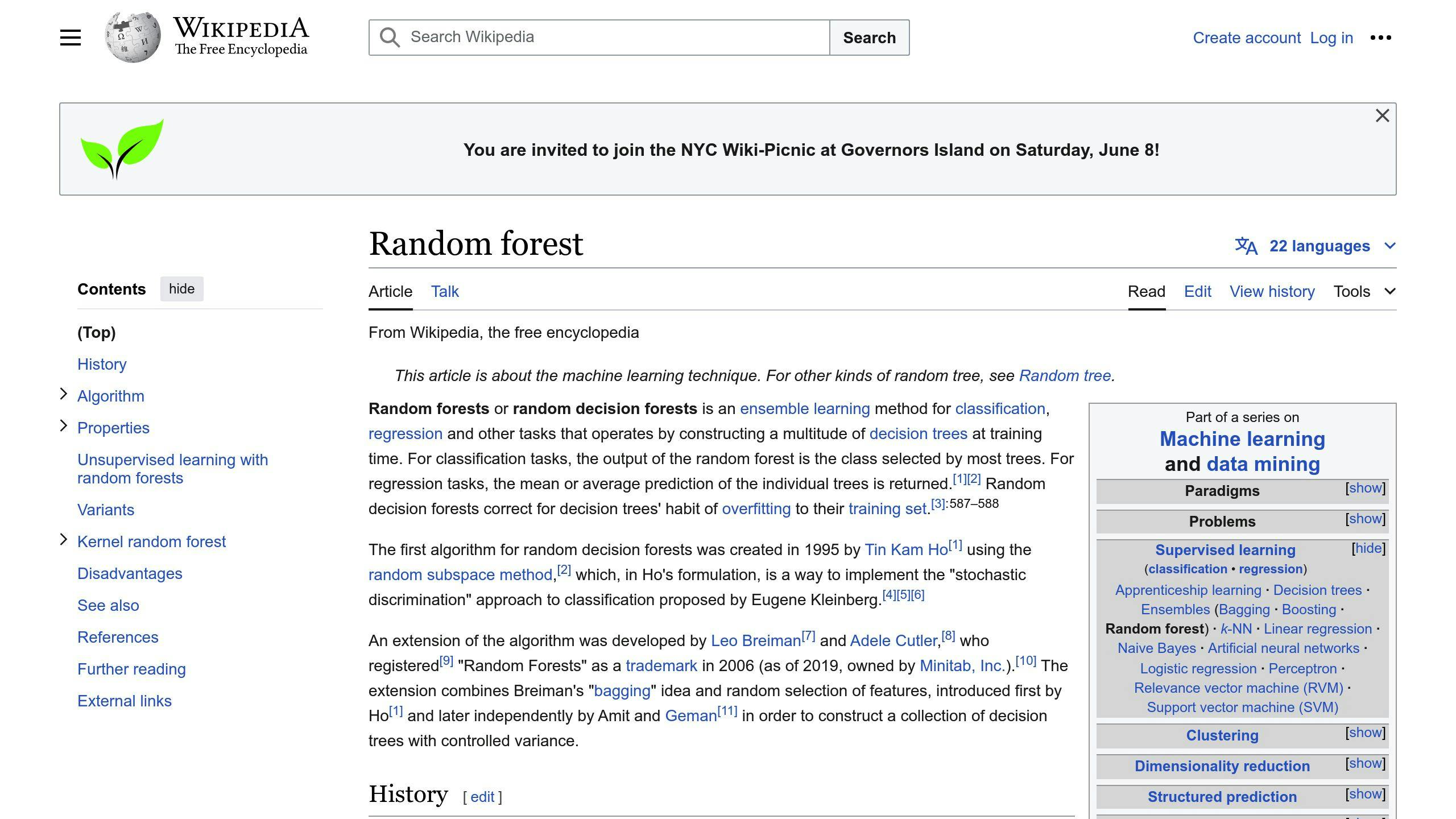Want to predict real estate prices accurately? Here's what you need to know about ensemble methods in 2024:
- Random Forest, XGBoost, and Stacking are top performers
- They combine multiple models for better predictions
- Each has strengths for different real estate scenarios
Quick comparison:
| Method | Best For | Key Strength | Top Performance |
|---|---|---|---|
| Random Forest | Big, messy datasets | Handles varied data well | 89% accuracy (Ames Housing) |
| XGBoost | Complex markets | High precision | 83.3% accuracy (California) |
| Stacking | High-stakes predictions | Combines model strengths | 17.83% error rate (Thai housing) |
Random Forest is great for general predictions. XGBoost shines in tricky markets. Stacking gives you the best of both worlds.
Bottom line: Ensemble methods are must-haves for smart real estate decisions in 2024.
Related video from YouTube
1. Random Forest Method

Random Forest is a big deal in real estate prediction. Why? It's great at handling the messy data that's common in housing markets.
Accuracy and Performance
Random Forest isn't just good - it's really good. Here's proof:
- It explained 89% of house price variance
- And it only needed 20 decision trees to do it
That's impressive for dealing with complex real estate data.
Handling Missing Data
Missing data? No problem. Random Forest has got it covered:
| Imputation Method | Sum of Absolute Differences |
|---|---|
| Miss Forest | 274.37 |
| Mice Forest | 361.46 |
| KNN | 397.26 |
Miss Forest, which uses Random Forest, beat out other methods. It's the go-to choice when you're missing data.
Feature Importance
Random Forest doesn't just predict - it explains. In Melbourne's Abbotsford area, it found these factors matter most for home prices:
- Building area
- Property type
- Number of rooms
- Location
This info is gold for real estate pros trying to understand their local markets.
Speed and Scalability
Random Forest is fast. It can train trees at the same time, making it perfect for big datasets. Some versions can work up to 10 times faster than other methods, without losing much accuracy.
Real-World Application
In a project to predict house prices:
- It hit 85% accuracy (using R-squared)
- It found the top predictors: overall quality, above-ground living area, and total basement square footage
This kind of insight is huge for investors, appraisers, and analysts.
Limitations
Random Forest isn't perfect:
- It can't reduce overfitting much more
- It might struggle with tons of variables
- It can be slow with really big datasets
But even with these drawbacks, it's still a top pick for real estate prediction.
As we head into 2024, Random Forest is a key player in real estate prediction. It handles mixed data, shows what's important, and makes solid predictions. For anyone trying to figure out property values or market trends, it's a must-have tool.
2. XGBoost Method

XGBoost (eXtreme Gradient Boosting) is a powerhouse in real estate prediction. It handles complex datasets like a pro, making it perfect for property value forecasting.
Accuracy That Matters
XGBoost doesn't just predict house prices - it nails them. Check out these results from a study using the Ames City, Iowa housing dataset:
| Regression Technique | Model Score | R-squared | MSE | MAE | CV Score |
|---|---|---|---|---|---|
| XGBoost | 0.997 | 0.920 | 0.015 | 0.084 | 88.940 |
What do these numbers mean? XGBoost explains 92% of the house price variance. Its low Mean Squared Error (0.015) shows high accuracy, and the cross-validation score (88.940) proves it performs well across different data subsets.
Tackling Real-World Data
Real estate data is messy. Missing values? Mixed features? XGBoost doesn't break a sweat:
- It handles missing data easily.
- It works with label-encoded data, turning text into crunchy numbers.
Take the California housing dataset. XGBoost achieved:
- Mean Absolute Error (MAE): 0.310
- R-squared: 0.833
These results show XGBoost can make accurate predictions in real-world scenarios.
Customizing for Success
XGBoost is flexible. You can tweak it to fit your specific real estate market. Here's a quick example:
model_XGB = XGBRegressor(n_estimators=10000, max_depth=7, eta=0.01, subsample=0.7, colsample_bytree=0.8)
This setup dives deep into the data with 10,000 trees and a max depth of 7, balancing detail and generalization.
Fighting Overfitting
Overfitting is a real concern in real estate prediction. XGBoost comes prepared with built-in regularization techniques (L1 and L2). These methods stop the model from memorizing training data, helping it generalize to new properties.
Speed and Smarts
XGBoost might need more computing power, but it's worth it. It learns from previous errors, improving accuracy with each step. This makes it ideal for high-stakes predictions in valuable real estate markets.
Real-World Use
Imagine a tool like Proptrends using XGBoost. It could boost market forecasts and investment scores, helping investors make smarter choices in the ever-changing real estate world.
As we head into 2024, XGBoost stands out for real estate prediction. It's accurate, flexible, and robust - a must-have for anyone diving into property valuation.
sbb-itb-9b72b50
3. Stacking Multiple Models
Stacking multiple models is like building a dream team for real estate prediction. It's all about combining different algorithms to create a super-powered forecasting tool. Here's how it's changing the game in 2024:
Mix and Match for Better Results
Stacking works by using the best parts of different models. Check out this real-world example:
A study on Thai housing prices used a stacked model that mixed:
- CNN for analyzing house photos
- Random Forests and XGBoost for number crunching
- Simple linear regression for baseline predictions
The result? This combo achieved a Mean Absolute Percentage Error of just 17.83%. That's way better than using any single model alone.
Picking the Right Players
Choosing your base models is crucial. A South Korean study on construction costs showed why:
| Base Model | Individual R² |
|---|---|
| Random Forest | 0.900 |
| Support Vector Machine | 0.897 |
| CatBoost | 0.906 |
When they stacked these models and added a linear regression on top, the R² jumped to 0.91. That's a solid boost in accuracy.
Real Estate Reality Check
How does stacking hold up in the real world? Pretty well, actually. A study from Jeju Island, South Korea, put different models head-to-head:
| Metric | Stacked Ensemble | XGBoost | AdaBoost |
|---|---|---|---|
| RMSE | 23,041,799.68 | 24,175,049.55 | 25,515,035.69 |
| R² | 0.9725 | Lower | Lower |
The stacked model came out on top with the lowest error and highest R². It's like the real estate prediction champion.
Stacking Smart
Want to try stacking? Here are some quick tips:
- Mix it up: Use different types of algorithms in your stack.
- Keep your data clean: Don't use the same data for training and testing.
- Fine-tune everything: Adjust your models for the best performance.
- Keep it simple on top: A basic model often works best for combining predictions.
What's Next for Stacking?
As we roll through 2024, stacking is getting even smarter. The D-Stacking method, for example, is showing some impressive results. It's managed to get Root Mean Square Errors down to 0.869 and 1.029 in tests with housing data from China and the USA.
Stacking isn't just a tech trick - it's changing how we value real estate. By combining different algorithms, we're getting closer to spot-on property predictions. This means everyone in the real estate game - buyers, sellers, and investors - can make smarter choices in a market that never stops moving.
Strengths and Limitations
Let's dive into the key differences between Random Forest, XGBoost, and Stacking models for real estate prediction. Each has its own pros and cons, so let's break it down:
| Method | Strengths | Limitations |
|---|---|---|
| Random Forest | • Handles big datasets well • Less overfitting • Can process in parallel • Easy to use and understand |
• Struggles with very complex data • Can be slow for large forests • Not great for predicting beyond training data |
| XGBoost | • Highly accurate • Built-in safeguards against overfitting • Handles missing data • Good at picking important features |
• Trickier to fine-tune • Can overfit if not set up right • Slow for big datasets |
| Stacking | • Combines multiple models' strengths • Often more accurate • Reduces errors from different angles |
• More complex • Takes longer to train • Can overfit if not careful |
Random Forest: The Reliable Workhorse
Random Forest is like the dependable pickup truck of machine learning. It's not flashy, but it gets the job done.
A study using the Ames Housing dataset showed that a Random Forest model with just 20 trees explained 89% of house price variance. That's pretty impressive for such a simple setup.
What's good:
- Handles messy data well (perfect for real estate)
- Tells you which features matter most
- Doesn't freak out over outliers (like that one mansion in a sea of apartments)
What's not so good:
- Can be slow with HUGE datasets
- Gets confused when features are too similar (like having both square footage and number of rooms)
XGBoost: The Accuracy Champion
XGBoost is the sports car of the bunch. It's fast, precise, and turns heads in the machine learning world.
In a study with California housing data, XGBoost nailed an R-squared value of 0.833. That's like predicting house prices with 83.3% accuracy!
What's good:
- Catches tricky patterns in data
- Has built-in features to prevent overfitting
- Handles different types of data well
What's not so good:
- Needs careful tweaking to work right
- Can go haywire with outliers if you're not careful
Stacking: The Best of All Worlds
Stacking is like building your own super-team of models. It's powerful but takes some skill to use right.
A study on Thai housing prices used a stacked model combining CNN, Random Forests, XGBoost, and linear regression. The result? A Mean Absolute Percentage Error of just 17.83%. That's way better than any single model could do.
What's good:
- Often the most accurate of the bunch
- Can handle both simple and complex patterns
- Lets you mix and match different models
What's not so good:
- Trickier to set up and understand
- Can overfit if you're not careful with your meta-model
So, which one should you pick? It depends on what you need:
- Got a big, messy dataset and need quick results? Go with Random Forest.
- Want top-notch accuracy and have time to tinker? XGBoost might be your best bet.
- After the absolute best performance and don't mind the extra work? Stacking could give you that edge in your real estate predictions.
Key Findings
We've dug into ensemble methods for real estate prediction in 2024. Here's what we found:
Performance Comparison
| Model | Strengths | Best Use Case | Key Metric |
|---|---|---|---|
| Random Forest | Handles big datasets, less overfitting | General real estate prediction | R² = 0.89 (Ames Housing dataset) |
| XGBoost | High accuracy, built-in regularization | Complex market analysis | R² = 0.833 (California housing data) |
| Stacking | Combines strengths of multiple models | High-stakes predictions | MAPE = 17.83% (Thai housing prices) |
Model-Specific Insights
Random Forest is a champ with messy real estate data. It explained 89% of house price variance in the Ames Housing dataset using just 20 trees. If you need to pinpoint what's driving property values, Random Forest is your go-to.
XGBoost shines in complex markets. It nailed an R-squared value of 0.833 with California housing data. That's impressive accuracy. Plus, it's got built-in features to keep it from overfitting, making it perfect for those roller-coaster real estate markets.
Stacking? It's the heavyweight for high-stakes predictions. A study on Thai housing prices used a stacked model (mixing CNN, Random Forests, XGBoost, and linear regression). The result? A Mean Absolute Percentage Error of just 17.83%. That's better than any single model could do on its own.
Practical Applications
When you're dealing with real-time data that's all over the place, engineers reach for XGBoost. Why? It handles class imbalance like a pro and gives extra attention to misclassified examples. That's gold in fast-moving real estate markets.
Future Outlook
As we cruise through 2024, one thing's clear: teamwork makes the dream work. Combining models is the way to go. Take the D-Stacking method, for example. It's showing some serious promise, with Root Mean Square Errors as low as 0.869 and 1.029 in tests with housing data from China and the USA.
In short: ensemble methods are killing it in real estate prediction. They're not just accurate - they're giving us insights we've never had before. And as the market keeps changing, these methods are only going to get more important.


